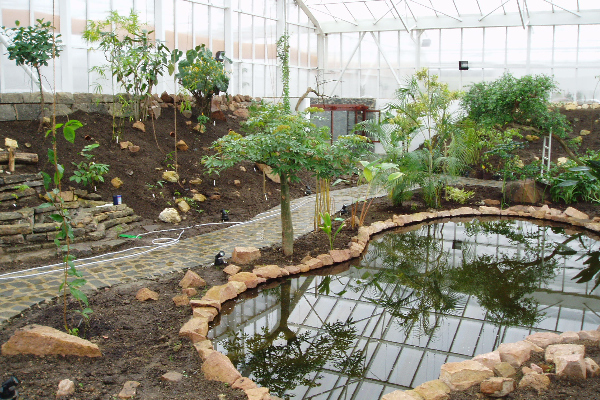
The modern Botanic Garden in Teplice was not built on a green field, its area has been used for garden purposes for about hundred years. We don´t know much about the real beginning of the garden by the end of 19th century. Perhaps Prince Edmund Clary-Aldringen played significant role in it but it may only be a rumour. We surely know that we find the word Stadtgärtnerei, meaning municipal gardening, in the construction plans of buildings coming from the year 1904. The original greenhouses, which mainly served to the spas for producing cut flowers or wintering palm trees and other mobile greenery, were reconstructed at the beginning of 70ies last century and made the botanic garden available for public in March 1975. But that time they were a part of the municipal Technical Services.

Since the 1970s, the Teplice Stock and Collection Garden was gradually developed and in 1975 it was opened to the public. On an area of 2 hectares it offered greenhouses with tropical, subtropical and succulent plants as well as an outdoor exhibition. It was an important educational and recreational centre and also produced plants for the city. In addition to selling plants and horticultural material, it provided guiding and consultancy services. It served as an oasis of nature in an industrial region, bringing the beauty of plants and relaxation to visitors and spa guests.

Marie Sternthalová (1948-2024) was a key figure in the history of the Botanical Garden Teplice. After studying phytotechnics, she headed the Stock and Collection Garden from 1971, where she initiated its opening to the public. She acquired valuable plant collections and opened the garden in 1975. After her politically forced retirement in 1977, she worked in horticulture and teaching. She remained a loyal visitor to the garden, where she enjoyed reminiscing. She was inspiring, energetic and optimistic. Her motto: "If you want to be happy all your life, become a gardener." Her last farewell was on October 4, 2024 in Teplice.

It took place in the Stock and Collection Garden of the City of Teplice from 6 to 8 July 1976. A total of 119 people attended the conference, 103 from Czechoslovakia and 16 from abroad (Bulgaria, GDR, Netherlands, Poland, Soviet Union). Among the prominent Czech botanists and horticulturists we select (in brackets always the institution for which they speak): Milan Blažek (BZ Průhonice), Jiří Haager (ČSAV Prague), Petr Herynek (BZ Praha-Troja), Josef Holzbecher (Arboretum and BZ VŠZ Brno), Vladimír Huml (BZ Praha-Troja), Vladimír Láník (BZ UJEP Brno, Antonín Nohel (Arboretum and BZ VŠZ Brno), Jiří Nohel (BZ UJEP Brno, now BZ MU Brno), Milena Roudná (BZ Průhonice), Kamila Skálová (BZ Praha-Troja), Pavel Smrž (BZ UK Praha).

Jiří R. Haager (1943–2022) was a prominent botanist and traveller who contributed to the development of the Botanical Garden of the Capital City of Prague. He was a major contributor to the Botanical Garden of Prague and the Botanical Garden of Teplice. Originally a biologist, he did not discover his passion for tropical plants until he was 30 years old. He traveled throughout Latin America and Southeast Asia collecting and describing new species. He has written 12 books, dozens of articles and has devoted himself to orchid hybridization. As director of botanical gardens, he built modern greenhouses and encouraged young botanists. He was known for his thrift, his passion for the exotic and his sense of humour. His legacy in botany and tropical plant cultivation remains alive.

The only botanical garden in the Ústí nad Labem region was established by the Statutory City of Teplice on the first of January 2002. At the time of its official establishment, the garden inherited about 2,000 species of plants. Less than half of them were planted in an outdoor exhibition of about one hectare, the greater part belonged to subtropical and tropical plants. Although the displays were created under rather emergency conditions, much was achieved thanks to the horticultural skill and, above all, the enthusiasm of the staff, and the garden was certainly worth a visit even before then. Among the unique species that you can still find there are the ancient specimen of the African conifer Afrocarpus gracilior (subtropical greenhouse) or the cycad Encephalartos villosus (subtropical greenhouse) from the same region, the beautiful Mexican Dasylirion serratifolium or the fifty-year-old cacti and other succulents from the collections of Professor F. Eck and the Teplice cactus grower V. Pulce.

After the establishment of the Botanical Garden Teplice in 2002, the number of plant species under cultivation increased significantly. In 2003, the construction of the 1,750 m² stock greenhouses began, completed in December of the same year. In 2004, the plants were moved to the new premises with minimal losses. By 2005, the number of species under cultivation had multiplied again. The outdoor display was modified, including the planting of new trees and the reconstruction of paths. A new 2 400 m² greenhouse was completed in December 2005. In October 2006, almost 14 500 visitors came to see it during the Open Days. The new era of the garden began with the opening ceremony on 1 May 2007.

The modern history since the opening of the new greenhouses has been written since 2007, with the development of the outdoor displays, the information system and new plant collections, based on the expeditions organized by the Botanical Garden in 2010-2015 to Chile, which enriched both the collection in the subtropical greenhouse and the outdoor display. In 2018, a new rockery greenhouse began to be added to the existing tropical complex, which was inaugurated in 2021. We achieved our first record attendance in 2022. A year later, a plan for the development of the entire garden was presented. In 2024, we received BGCI accreditation and began design documentation for a new greenhouse facility for the collections, including an education pavilion.